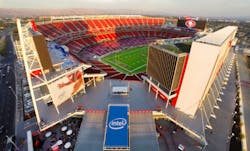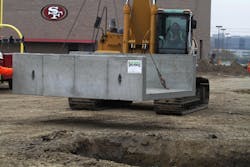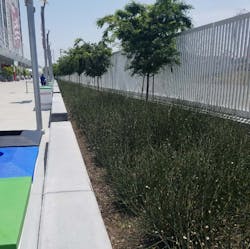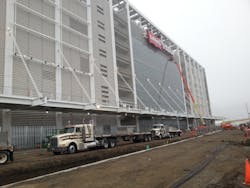New San Francisco 49ers Stadium Scores Big with BIOMOD® Stormwater Management System
New San Francisco 49ers Stadium Scores Big with BioMod® Stormwater Management System
A large construction project such as a major-league sports stadium can include significant expanses of runoff-generating hardscape. A venue capable of seating nearly 70,000 people requires large parking areas and other impervious grounds. If rainwater can turn a football field into a muddy swamp, it can also turn a parking lot into a floodplain. Draining that area effectively and treating the runoff is a basic necessity that should be provided from the very beginning of the project, but it can present challenges.
The new San Francisco 49ers stadium in Santa Clara, California is a good case in point. The new stadium moved the team out of Candlestick Park into a location with about double the square footage, better freeway access and about twice the parking spaces. Parking lot runoff typically includes petrochemical pollutants that drip or leak from vehicles, as well as litter and other debris. The new stadium sits adjacent to San Tomas Aquino Creek, which flows into San Francisco Bay less than six miles away. The site is on land with a high-water table, and existing storm-drain lines are not very far below the surface. As such, a stormwater infiltration system would not work.
To handle stormwater runoff from the parking lots, access roads and other hardscapes surrounding the stadium, project manager GHD Engineering selected the BioMod® biofiltration system, a stormwater collection and natural treatment system manufactured by industry leader Oldcastle® Precast. Today, the stadium has six biofiltration systems to naturally treat and manage stormwater runoff from the parking lots and grounds immediately adjoining the site.
In total, about 2,500 linear feet of BioMod cells or approximately 14,000 square feet of bioretention area currently treat stormwater runoff from the complex. While the standard bioretention modules used in most of the 49ers project are three-feet wide, two systems in the second phase featured tapered plans: one three-feet wide at one end and 14-feet at the other, an irregular wedge over 300-feet long. The other is 230-feet long and rectangular over most of its length, with a subtle taper at the south end. The unusual shapes were designed by the architect with specific visual goals in mind.
The main parking lot has two biofiltration systems. The one on the north side featuring the rounded modules was manufactured and installed first. The main run is nearly three-feet wide and just over 600-feet long, mostly basic curb-cut units without pre-filtration. The modules that lie perpendicular to the main run are seven-feet wide. They divide the parking lot into six Drainage Management Areas (DMAs), each about 100-feet long for managing about 10,000 square feet of surface runoff.
Water is one of nature’s most powerful forces. Hardscaping can turn that force destructive, both in terms of erosion and pollution. A properly design stormwater management system has three essential functions:
- Remove rainwater from the hardscape and other impervious surfaces
- Channel runoff so it does not erode the surrounding landscape
- Treat runoff so it does not pollute the landscape or downstream waters
Biofiltration is one of the simplest, most natural and cost-effective ways to collect runoff and treat it on-site, and is considered a best practice under U.S. Environmental Protection Agency (EPA) guidelines for Low-Impact Development (LID).
During storm events, rainwater runs into the modules, ponds and then slowly percolates into the media where it is naturally filtered along the way. The treated water is collected in a perforated pipe that runs along the bottom of the biofiltration system and ultimately links into the storm-drain system.
Filtered pollutants are naturally broken down by microbes, providing nutrients for the plants which are irrigated by the rainwater. In locations where rainfall may not be frequent or consistent enough to sustain them – such as the new 49ers stadium – integral drip-lines can be built into the modules to deliver supplemental irrigation.
BioMod systems can include basic units with small ornamental plantings, tree modules, pre-filtration units, light pole modules as well as custom designs. Pre-filtration modules have an upper chamber designed to collect litter and other solid debris, and detain it so it does not interfere with drainage. Pre-filtration units must be periodically cleaned to dispose of the collected debris.
Overflow drains can be added to handle extremely heavy rains. During unusually high flows, when the ponding depth cannot be drained fast enough through the filtration media to keep up with the rainfall, excess water is diverted into the overflow drains and then into the storm-drain system. The stadium system was designed to handle a 10-year rain event. Having an integrated overflow bypass built into the biofiltration system eliminates the need to design and install a separate peak conveyance system, as is often necessary with other biofiltration setups.
The drainage rate is determined by the surface area of the bioretention system and by the composition of the filtration media. The BioMod system does not require proprietary biofiltration media. For the 49ers stadium, engineers selected a blend that yields up to 10 inches per hour of drainage in accordance with Contra Costa County requirements. Other media blends are capable of treating as much as 100 inches of rainwater per hour, as needed. Computed against the size of the impervious hardscape and the predicted rainfall, the size of the required bioretention system can quickly be calculated. However, the media must be selected not only for drainage characteristics, but also for compatibility with the intended plantings.
One of the greatest advantages of a biofiltration system is that it is easy to maintain and essentially self-sustaining. It harnesses nature to break down petrochemical pollutants, a process that needs little help from us. Debris must be occasionally removed from the system, and plants must be maintained like any other landscaping, but little more is necessary. The San Francisco 49ers biofiltration system will largely maintain itself, keeping the grounds looking good and safe from flooding, while protecting the San Francisco Bay and other sensitive areas surrounding it from stormwater pollutants.




